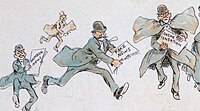
Photo from wikipedia
BACKGROUND Many studies have examined 'non-specific' vaccine effects on infant mortality: attention has been particularly drawn to diphtheria-tetanus-pertussis (DTP) vaccine, which has been proposed to be associated with an increased… Click to show full abstract
BACKGROUND Many studies have examined 'non-specific' vaccine effects on infant mortality: attention has been particularly drawn to diphtheria-tetanus-pertussis (DTP) vaccine, which has been proposed to be associated with an increased mortality risk. Both right and left censoring are common in such studies. METHOD We conducted simulation studies examining right censoring (at measles vaccination) and left censoring (by excluding early follow-up) in a variety of scenarios in which confounding was and was not present. We estimated both unadjusted and adjusted hazard ratios (HRs), averaged across simulations. RESULTS We identified scenarios in which right-censoring at measles vaccination was informative and so introduced bias in the direction of a detrimental effect of DTP vaccine. In some, but not all, situations, adjusting for confounding by health status removed the bias caused by censoring. However, such adjustment will not always remove bias due to informative censoring: inverse probability weighting was required in one scenario. Bias due to left censoring arose when both health status and DTP vaccination were associated with mortality during the censored early follow-up and was in the direction of attenuating a beneficial effect of DTP on mortality. Such bias was more severe when the effect of DTP changed over time. CONCLUSIONS Estimates of non-specific effects of vaccines may be biased by informative right or left censoring. Authors of studies estimating such effects should consider the potential for such bias and use appropriate statistical approaches to control for it. Such approaches require measurement of prognostic factors that predict censoring.
Journal Title: International journal of epidemiology
Year Published: 2019
Link to full text (if available)
Share on Social Media: Sign Up to like & get
recommendations!